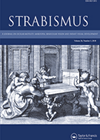
Journal Reviews archive for August 2014
Near cue responses
The authors tested subjects with esotropia (13 constant esotropia, 16 fully accommodative esotropia and eight convergence excess) versus age-matched controls and 27 young adult emmetropes for response profiles in comparison to matched control groups. They found responses to the all-cue...
AC/A correlates
Three groups of subjects were included in this study. Group 1 had typically developing children from five to nine years with heterophoria less than 6PD. Group 2 had 19 children aged five to nine years with intermittent distance exotropia. Group...
Vision screening opinion
The aim of this paper is to describe experts’ perceptions of best practice guidelines and competency frameworks for visual screening in children. A focus group of approximately 75 minutes duration consisted of five orthoptists and two paediatric ophthalmologists with more...
AC/A non-linearity
This study investigated whether or not the response accommodative convergence to accommodation (AC/A) ratio in 30 visually normal subjects is linear with lens presentation order counterbalanced. Accommodative response was measured using the Shin Nippon SRW 500 infrared autorefractor. Accommodation was...
CFEOM outcomes
This study presents the orbital and cranial magnetic resonance imaging (MRI) findings of patients diagnosed with congenital fibrosis of the extraocular muscles (CFEOM) along with the surgical procedures and outcomes for ocular motility and strabismus. Nine patients are described: three...
Plusoptix referral criteria
The authors compared various referral criteria on the same group of patients to determine the sensitivity, specificity and predictive value of each. They also programmed the plusoptix to use the 2013 American Association for Pediatric Ophthalmology and Strabismus (AAPOS) referral...
Reduced angle after BT for postop diplopia test
The authors undertook a retrospective study to evaluate the extent of reduced deviation after Botulinum toxin (BT) when used as a postoperative diplopia test. They evaluated effect in 39 patients: 32 exotropia and seven esotropia. The same BT dose was...
Angle of deviation and psychological impact
This questionnaire-based prospective study using the Psychological Impact Questionnaire was designed to investigate whether the size of the angle of deviation, age, sex, presence of diplopia, visual acuity of the worse eye and direction of deviation are related to psychological...
Orthoptic slit-lamp
Adaptations are described that allow the slit-lamp to be used to document squint disorders. Changes are made in the observation system, illumination system, for recording clinical findings and visualisation of clinical findings. The author includes the use of minus lens...
Childhood visual development in albinism and infantile nystagmus
The authors compare monocular and binocular development measures in 16 children with albinism, 10 with infantile nystagmus (INS) and 72 with normal vision to address interocular acuity differences, crowding ratios and binocular summation rates. The children were aged between four...
Strabismus detection by Plusoptix S08
In this study the authors evaluate the accuracy and sensitivity of the Plusoptix S08 photoscreener in detecting strabismus problems in 83 patients aged from six months to 40 years (mean 105 months). A pass was achieved for 25 patients and...
Strabismus outcomes after retinal detachment surgery
A retrospective study reviewed the motor outcomes of strabismus surgery in a cohort of 18 patients who had all previously undergone a scleral buckling procedure to treat retinal detachment. The mean age at strabismus surgery was 48 years (14-67) and...





